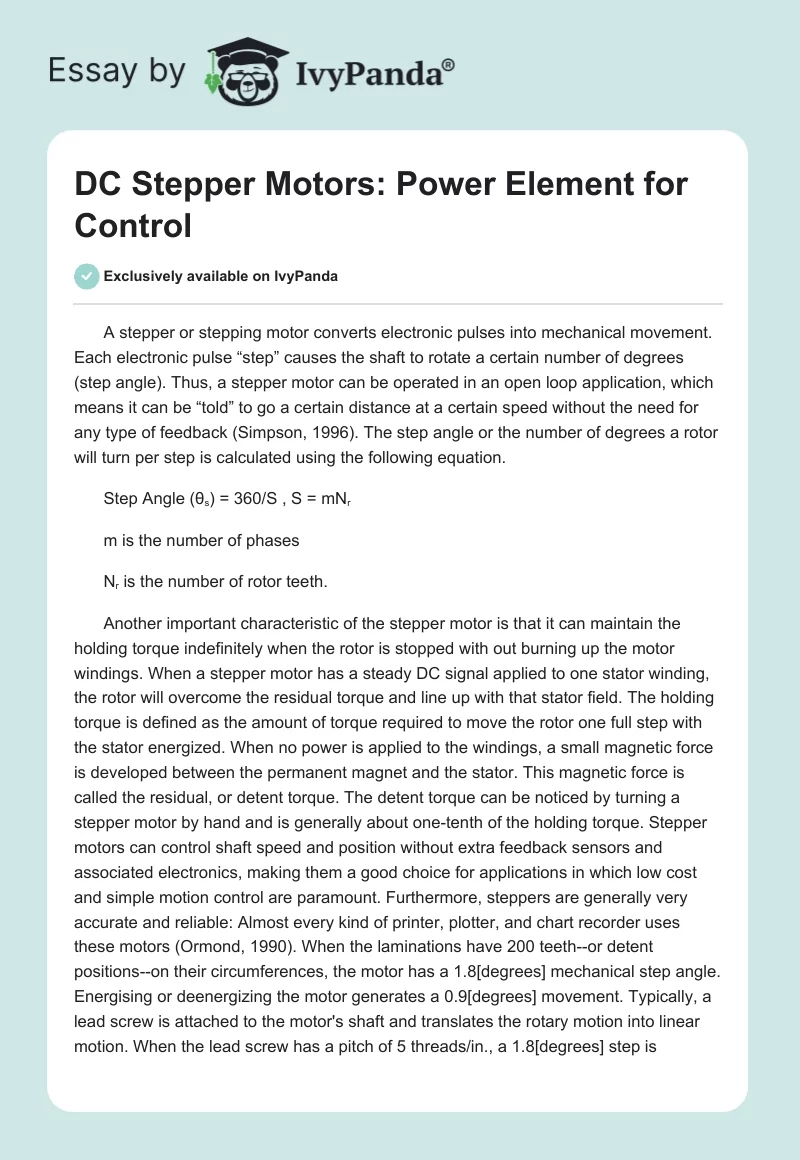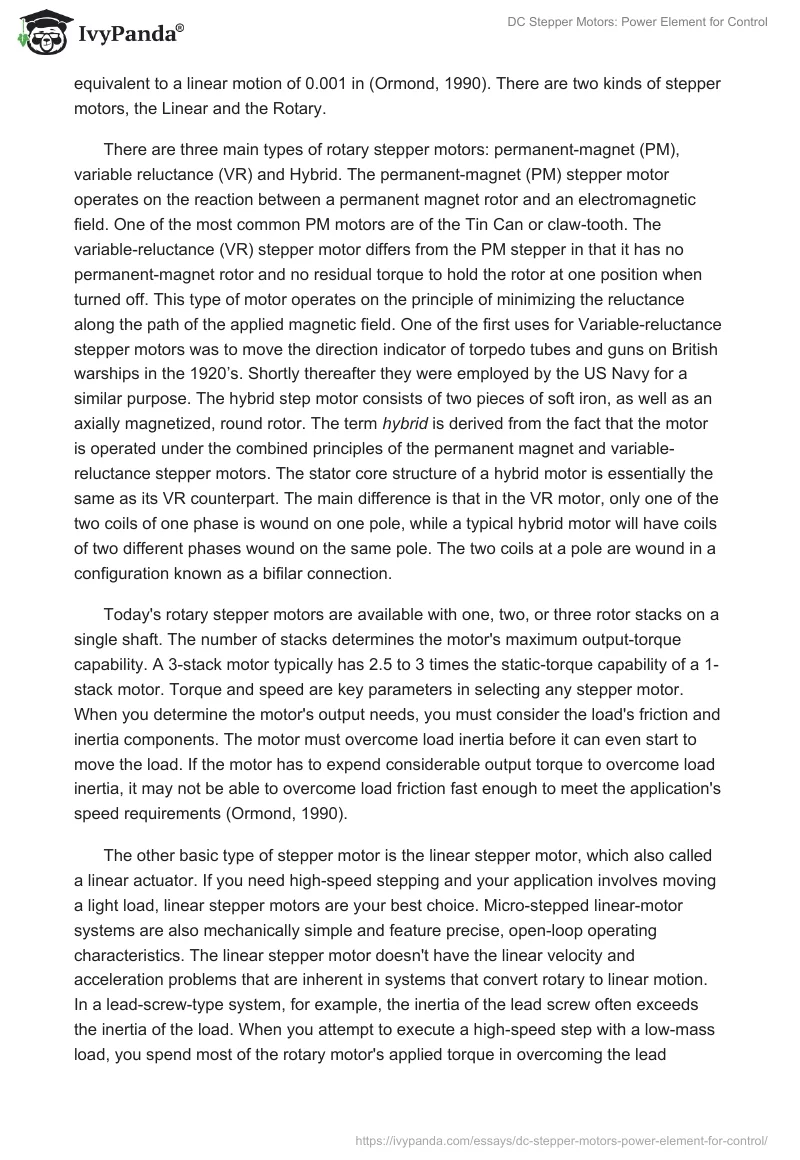A stepper or stepping motor converts electronic pulses into mechanical movement. Each electronic pulse “step” causes the shaft to rotate a certain number of degrees (step angle). Thus, a stepper motor can be operated in an open loop application, which means it can be “told” to go a certain distance at a certain speed without the need for any type of feedback (Simpson, 1996). The step angle or the number of degrees a rotor will turn per step is calculated using the following equation.
Step Angle (θs) = 360/S , S = mNr
m is the number of phases
Nr is the number of rotor teeth.
Another important characteristic of the stepper motor is that it can maintain the holding torque indefinitely when the rotor is stopped with out burning up the motor windings. When a stepper motor has a steady DC signal applied to one stator winding, the rotor will overcome the residual torque and line up with that stator field. The holding torque is defined as the amount of torque required to move the rotor one full step with the stator energized. When no power is applied to the windings, a small magnetic force is developed between the permanent magnet and the stator. This magnetic force is called the residual, or detent torque. The detent torque can be noticed by turning a stepper motor by hand and is generally about one-tenth of the holding torque. Stepper motors can control shaft speed and position without extra feedback sensors and associated electronics, making them a good choice for applications in which low cost and simple motion control are paramount. Furthermore, steppers are generally very accurate and reliable: Almost every kind of printer, plotter, and chart recorder uses these motors (Ormond, 1990). When the laminations have 200 teeth–or detent positions–on their circumferences, the motor has a 1.8[degrees] mechanical step angle. Energising or deenergizing the motor generates a 0.9[degrees] movement. Typically, a lead screw is attached to the motor’s shaft and translates the rotary motion into linear motion. When the lead screw has a pitch of 5 threads/in., a 1.8[degrees] step is equivalent to a linear motion of 0.001 in (Ormond, 1990). There are two kinds of stepper motors, the Linear and the Rotary.
There are three main types of rotary stepper motors: permanent-magnet (PM), variable reluctance (VR) and Hybrid. The permanent-magnet (PM) stepper motor operates on the reaction between a permanent magnet rotor and an electromagnetic field. One of the most common PM motors are of the Tin Can or claw-tooth. The variable-reluctance (VR) stepper motor differs from the PM stepper in that it has no permanent-magnet rotor and no residual torque to hold the rotor at one position when turned off. This type of motor operates on the principle of minimizing the reluctance along the path of the applied magnetic field. One of the first uses for Variable-reluctance stepper motors was to move the direction indicator of torpedo tubes and guns on British warships in the 1920’s. Shortly thereafter they were employed by the US Navy for a similar purpose. The hybrid step motor consists of two pieces of soft iron, as well as an axially magnetized, round rotor. The term hybrid is derived from the fact that the motor is operated under the combined principles of the permanent magnet and variable-reluctance stepper motors. The stator core structure of a hybrid motor is essentially the same as its VR counterpart. The main difference is that in the VR motor, only one of the two coils of one phase is wound on one pole, while a typical hybrid motor will have coils of two different phases wound on the same pole. The two coils at a pole are wound in a configuration known as a bifilar connection.
Today’s rotary stepper motors are available with one, two, or three rotor stacks on a single shaft. The number of stacks determines the motor’s maximum output-torque capability. A 3-stack motor typically has 2.5 to 3 times the static-torque capability of a 1-stack motor. Torque and speed are key parameters in selecting any stepper motor. When you determine the motor’s output needs, you must consider the load’s friction and inertia components. The motor must overcome load inertia before it can even start to move the load. If the motor has to expend considerable output torque to overcome load inertia, it may not be able to overcome load friction fast enough to meet the application’s speed requirements (Ormond, 1990).
The other basic type of stepper motor is the linear stepper motor, which also called a linear actuator. If you need high-speed stepping and your application involves moving a light load, linear stepper motors are your best choice. Micro-stepped linear-motor systems are also mechanically simple and feature precise, open-loop operating characteristics. The linear stepper motor doesn’t have the linear velocity and acceleration problems that are inherent in systems that convert rotary to linear motion. In a lead-screw-type system, for example, the inertia of the lead screw often exceeds the inertia of the load. When you attempt to execute a high-speed step with a low-mass load, you spend most of the rotary motor’s applied torque in overcoming the lead screw’s inertia. In addition, the screw’s inertia increases as its length increases, which tends to reduce the motor’s critical maximum speed. With linear devices, the force generated by the motor is applied directly to the load, and the screw’s length has no effect on system inertia. A linear hybrid stepper operates on the same electromagnetic principles as a rotary hybrid stepper. Linear devices from Compumotor feature a moving element called the forcer and a stationary part called the platen. The platen (or stator) is a passive, serrated steel bar that extends over the desired length of travel. The forcer (or armature) consists of two electromagnets (phase A and phase B) and a strong, rare-earth permanent magnet.
The two pole faces of each electromagnet have teeth that concentrate the magnetic flux. Four sets of teeth on the forcer are arranged in spatial quadrature so that only one set at a time will align with the platen teeth. The magnetic flux passing between the forcer and the platen creates a strong attraction force between the two pieces. When current flows in a field winding, the resulting magnetic field tends to reinforce the permanent magnetic flux at one pole face and cancel it at the other. Reversing the current reverses the cancellation and reinforcement effects. When no current is present, the permanent magnetic flux divides itself equally between the two pole faces. By judiciously applying current to phases A and B, you can concentrate the flux at any of the forcer’s four pole faces. The face with the highest flux concentration will attempt to align its teeth with the platen. The platen will continue to move as long as you repeat the current sequence. When you stop the sequence, the forcer stops with the appropriate tooth set aligned. At rest, the forcer develops a restoring or holding force, which resists any attempt to displace the forcer from equilibrium. The restoring force will continue to increase until the resting motor’s displacement is one-fourth of a tooth interval. Beyond this point, the restoring force drops.
If the motor is pushed over the crest of its holding force, the motor will slip or jump and come to rest at an integer number of tooth intervals away from its original location. When the forcer is traveling along the platen, this slip-page or jumping is referred to as a stall condition (Ormond, 1990). A stepper motor can be a good choice whenever controlled movement is required. They can be used to advantage in applications where you need to control rotation angle, speed, position and synchronism. Because of the inherent advantages listed previously, stepper motors have found their place in many different applications. Some of these include printers, plotters, high end office equipment, hard disk drives, medical equipment, fax machines, automotive and many more. It can be used as a position magnetic pick up for floppy disks, carriage drive, rotate character wheel, paper feed, ribbon wind and as position matrix head for printers. It is also used in paper feed and lens positioning for copy machines, credit card and paper feed for banking machines. For process applications, it is used in air-fuel mixture adjustment for carburettor, as fluid gas metering for valve control, parts positioning for production lines and in-process gauging. Its applications is also extended to machine tools, it is basically used in x-y-z positioning for milling machines, drilling machines, laser cutting, sewing and electron beam welding (Kissel, 2006).
References
Bartos, F., 2000 “New ways to control Stepper Motors”. Control Engineering Europe. Web.
“Basics of Design Engineering”, 2007 Copyright © 2007 Penton Media, Inc. & Machine Design magazine. Web.
Editors, 2004.“DC micro motors for high volume applications” ECN-Electronic Component News.
Editors, 2001. “Stepper/servo motor brakes.” Mechanical Engineering-CIME.
Editors, 2000. “MAGNET STEPPER MOTOR”. Industrial Maintenance & Plant Operation.
Gooch, S. 2001 “Sewing: A Portable Game”. Medical Equipment Designer.
Kenjo, T. and Sugawara, A. 1994“Stepping Motors and their Microprocessor Controls” Oxford Science Publications Copyright 1994.
Kissell, T.. 2006.“Industrial Electronics”.Prentice Hall 2006, ISBN: 0-13-012697-7, 2006.
Lefebvre, M. 2005, “Dynamics of hybrid stepper motors: steppers position precisely if loads are stable and speeds stay below 1,000 rpm” Machine Design.
Ormond, T., 1990. “Devices handle strict positioning needs: stepper motors.” EDN.
Simpson, C. D. 1996.“Industrial Electronics” by Colin D. Simpson, Prentice Hall PTR. Copyright 1996.


